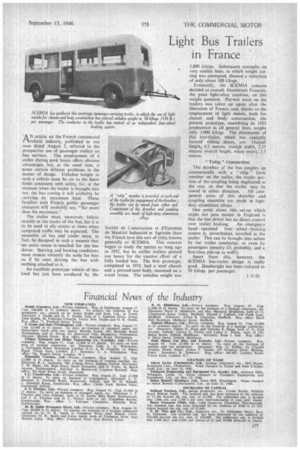Light Bus Trailers in Fiance
Page 29

If you've noticed an error in this article please click here to report it so we can fix it.
AN article on the French commercial vehicle industry, published in our issue dated August 2, referred to the prospective use of passenger trailers on bus services. The employment of a trailer during peak hours offers obvious advantages, but, at the same time, it poses certain delicate problems in the matter of design. Unladen 'weight in such a vehicle must be cut to the finest limits consistent with safety, for, at the moment when the trailer is brought into use, the bus towing it will probably be carrying its maximum load. Those familiar with French public passenger transport will probably say, "far more than the maximum."
The trailer must, moreover, follow exactly in the tracks of the bus, for it is to be used in city streets at times when congested traffic may be expected. The ensemble of bus and trailer must, in fact, be designed in such a manner that no extra strain is -entailed for the bus driver. Steering and braking conditioni must remain virtually the suite for him as if he were driving the bus with nothing attached to it.
An excellent prototype vehicle of this kind has just been produced by the
Societe de Construction et d'Entretien de Materiel Industriel et Agricole (how the French love this sort of title), known generally as SCEMIA. This concern began to study the matter so -long ago as 1932, but its earlier trailers proved too heavy for the tractive effort of a fully loaded bus. The first prototype, completed in 1933, had a steel chassis and a pressed-steel body, mounted on a wood frame. The unladen weight was
3,800 kilogs. Subsequent examples On very similar lines, in Which weight 'cutting was attempted, showed a reduction of only about 100 kilogs.
Eventually, the . SCEMIA concern decided to consult Aluminium Francais, the great light-alloy combine, on this weight question. Pre-war work on the trailers was taken up again after the liberation of France, and, thanks to the employment of light metals, both fcir chassis and body construction, the present prototype, resembling its 1933 predecessor in all general lines, weighs only 1;990 kilogs. The dimensions of this bus.-trailer, Which has centrally located sliding doors, are: Overall lenithi, 62 metres; oVerafi width, 2.35 metres; overall height, when empty, 2.7
metres. • "Tulip" Connection • The drawbar of the bus couples up automatically with a "tulip" form member on the trailer, the trailer portion of the coupling being duplicated at the rear, so that the trailer may be
towed in either direction. All component parts of this drawear and coupling ensemble are made in highduty aluminium alloys.
One point about this set-up which might not pass muster in England is that the bus driver has no direct control over trailer braking. An emergency hand operated four wheel braking system is, nevertheless, installed in the trailer. This can be brought into action by the trailer conductor, or even by passengers (penalty £5. probably, and a first-class pile-up as well).
Apart from this, however, the SCEMIA bus-trailer design is really good. Deadweight has been reduced to 50 kilogs. per pssenager.
I .G.D.




































































